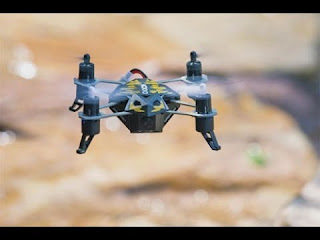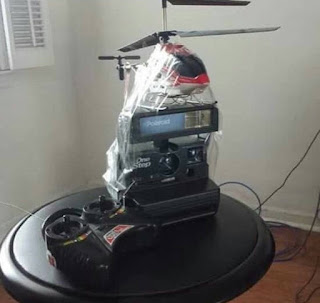The Kodo’s Status
I have been flying the Kodo every day to practice. During the week I practice at sunset and on weekends I try to practice at sunrise and sunset to get 2 sessions of practice for the day. As with anything of this nature, practice makes perfect and that is true here.
I have been getting better with it. Hover is no issue. I can fly the quad around a bit and generally
stay in control. I do not feel like the
quad gets away from me (as in I cut the throttle because it’s no longer
controllable by me).
My training regimen consists of the following (I break down
the exercises by battery):
- 1st battery: Warmup and basic hover practice
- 2nd battery: Hop between 2 spots on the ground about 15’ apart
- 3rd battery: practice 10:00 and 2:00 hover*
- 4th battery: practice 10:00 and 2:00 hover*
- 5th battery: Have some fun
*3rd and 4th batteries are used to
hover the quad while the front of the quad is aimed at the 10:00 angle and 2:00
angle. Once I have those mastered, I
will move on to a 9:00/3:00 angle and after that I will move to nose in
hovering (quad is facing me, controls are reversed).
Ultimately, I will be happy when I can do a nose-in hover
with ease as well as fly in a circle and a figure 8. That is the goal.
In other Kodo news, I have been using my GoPro to record my
sessions with the Kodo. I will cut
together some of that and post it up here so you can see my pathetic attempts
at flying. This past weekend, while
flying the Kodo in the backyard, the Kodo decided to take off on its own and it
slammed into a wall behind me as I was flying it.
I thought it was odd and that maybe there was some RF interference
that caused it to do that so I moved to the other side of the yard. I flew for a few minutes before the Kodo
decided to slam into my shin and cut me.
Again I dusted it off and flew for a little while without incident.
On the last battery, the Kodo flew for about 2 minutes and
then I landed it. Attempting to take off
again failed as the left front motor died.
I attributed the the odd flight characteristics exhibited by the Kodo
previously to this motor failure and indeed the GoPro footage confirmed this.
We ordered a new motor on Amazon for it (they come in pairs
for about $10) and I will replace the dead one once the new one arrives.
So, sadly, no more Kodo practice until I get my new
motor. Guess I will have to play with the
P3P then…
The Phantom 3 Professional
We had the P3P for a little over a week before we actually got around to unboxing it and setting it up. The boxes that it shipped in were pretty beat up by UPS but nothing inside was damaged.
Speaking of, it seems like UPS’s disrespect for packages has
increased of late. Was a time when most
packages were intact. Now I do not
remember the last time that happened…
We only have 1 device that will run the DJI Phantom app (the
GO app) and that is my iPad Air (first gen).
My wife is considering a new iPhone 6s+ or an iPad Air II so we will be
able to use those as well.
We charged up the batteries and the remote, installed the
app and attempted to power the rig up.
We turned the remote on first with the iPad (ALWAYS turn the remote on
first (and LAST) – If you power up the quad first, it may think it has lost
connection to the remote and attempt to do a return to home – to whatever its
last home point was…).
Once all of that was up and running and the app was talking
to the remote, we removed the quad’s camera gimbal clamp and powered up the quad
(sans props of course) which emitted a rather loud set of musical tones. When the app started talking to the quad and
displaying its camera feed, we noticed that it reported a gimbal error and that
it wanted to have its firmware updated.
The gimbal error was a bit dismaying but after a bit of
online research, some folks indicated that the gimbal could report a false
error with certain firmware versions. So
the first task was to update the firmware.
Updating the Firmware
This was a pretty painless process. I downloaded the latest firmware from DJI,
copied the .BIN file to the microSD card, inserted the card into the P3P and
powered it up. This is the ONLY instance
where you can power up this quad without the remote being turned on first.
The P3P took about 25 minutes to perform the update and
during that time emitted a constant beeping sound. I expected this after reading up on it online
so I put it in the bathroom expecting it to be as loud as the startup sounds
but that was not the case. The beeping
was pretty quiet after all but I left it in the bathroom with the door open so
I could hear the louder beeps it might make.
Following the P3P’s update, I attempted to update the remote
control. As it turned out, there was no update
for the remote in the update file that I used for the P3P. It turns out that I had to download the
previous firmware file and it had the update so we were able to update the
remote with no issues The remote took
about 10 minutes to perform the firmware update.
The final status
Once updated, the app no longer complained about a gimbal
error. YAY! However I was not convinced that the gimbal
was 100%. I noticed it twitching left
and right when the P3P was just sitting idle. I decided to pick up the P3P and walk around
the house with it while recording.
When I reviewed that footage, the image was very shaky and
unstable. I was very disappointed but
thought that maybe when the P3P is in flight that the gimbal would just work. However, it turns out that there is yet
another bit of packing material that is wedged behind the gimbal for shipping
purposes.
Once I removed it, the gimbal worked perfectly. No twitching while it is idle and walking
through the house with it looked smoother than a Steadicam shot. Excellent.
Once all of that was resolved, both my wife and I were able
to make good use of the simulator. My
initial practicing involved getting the quad to fly in a circle with combined
rudder/yaw. I think it will help a lot
with this coordinated skill. I started
by applying 100% rudder (roll) so the quad would spin in place and then slowly
started adding in YAW, the effect being that as I added more and more YAW, the
size of the circle increased. Still a
lot of practice to do on that.
We have not flown the P3P yet as we are still waiting for
the Strong Arm reinforcements. And, with
that, we may have run into a small snag.
We plan to use the Strong Arms with a set of Bestem quick release prop
guards. We need the quick release so
that we can use the backpack case. The
Strong Arm product supports being used in conjunction with the Bestem guards
but we need to understand how much we will need to modify the backpack case’s
foam to accommodate this.
In the next installment, I will have actual footage from our
maiden flight so stay tuned!








